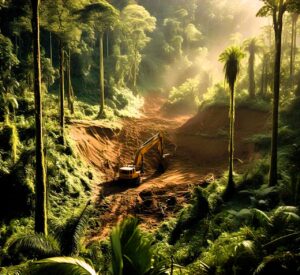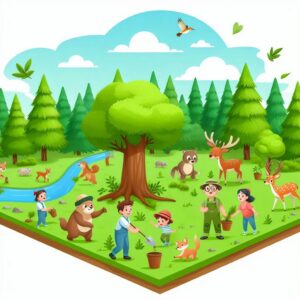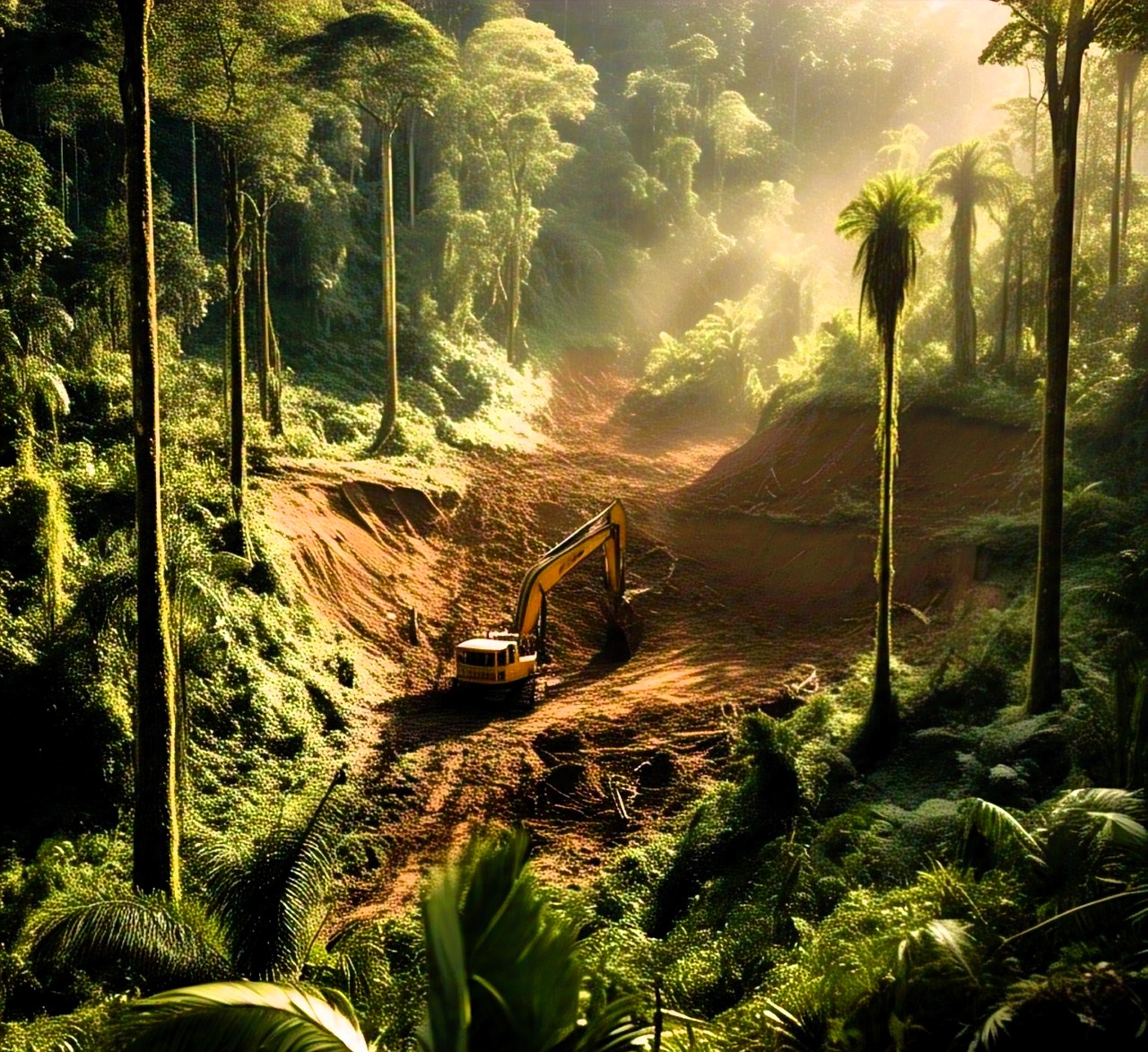Understanding Deforestation: Causes, Effects, and Solutions in 2025
deforestation, the clearing or thinning of forests by humans. Deforestation represents one of the largest issues in global land use. Estimates of deforestation traditionally are based on the area of forest cleared for human use, including the removal of trees for wood products and for croplands and grazing lands. In the practice of clear-cutting, all the trees are removed from the land, which completely destroys the forest. In some cases, however, even partial logging and accidental fires thin out the trees enough to change the forest structure dramatically.

Learn about deforestation, its causes, environmental effects, and the importance of conservation. Discover the impact of deforestation on biodiversity, climate change, and sustainable forest management.
Deforestation is the clearing of forests, usually as a result of human activities like agriculture, urbanisation, and logging. It is a significant environmental concern with far-reaching consequences for biodiversity, climate change, and sustainable forest management. In this article, we will explore the causes and effects of deforestation and potential solutions to this growing problem.
The History of Deforestation: A Timeline of Destruction
Deforestation, the clearance of forests, has been a persistent threat to the environment for centuries. The history of deforestation is a complex and multifaceted one, with various factors contributing to the destruction of forests over time.
Ancient Civilisations (3000 BCE – 500 CE)
- Agriculture and settlement: The development of agriculture and the growth of settlements led to the clearance of forests for farming, housing, and other purposes.
Ancient Greece and Rome: The ancient Greeks and Romans cleared forests for urbanisation, agriculture, and timber, leading to significant deforestation in the Mediterranean region
Middle Ages (500 – 1500 CE)
- Medieval agriculture: The expansion of agriculture during the Middle Ages led to further deforestation, as forests were cleared for farming and livestock grazing
- Charcoal production: The demand for charcoal, used for fuel and metalworking, contributed to deforestation in Europe during this period.
Colonial Era (1500 – 1900 CE)
- Colonisation and deforestation: European colonisation of the Americas, Africa, and Asia led to widespread deforestation, as forests were cleared for plantations, settlements, and resource extraction.
- Timber trade: The growth of international trade in timber and other forest products accelerated deforestation, particularly in the tropics.
Industrial Era (1900 – 2000 CE)
- Industrial agriculture: The development of industrial agriculture, with its emphasis on large-scale monoculture farming, led to significant deforestation, particularly in the tropics.
- Urbanisation and infrastructure: The rapid growth of cities and infrastructure, such as roads and dams, contributed to deforestation, as forests were cleared for urban expansion and development.
Modern Era (2000 CE – present)
- Soy and palm oil production: The expansion of soy and palm oil production, driven by demand for biofuels and food, has led to widespread deforestation, particularly in the Amazon and Southeast Asia.
- Climate change and deforestation: The impact of climate change on forests, including increased frequency and severity of wildfires, has exacerbated deforestation, while deforestation itself contributes to climate change.
Consequences
- Biodiversity loss: Deforestation has led to the loss of countless species, as habitats are destroyed and ecosystems are disrupted.
- Climate change: It contributes to climate change, as forests are cleared and carbon is released into the atmosphere.
- Soil erosion and water pollution: It can lead to soil erosion and water pollution, as tree roots no longer hold soil in place, and pollutants are released into waterways.
Solutions to Deforestation
- Sustainable forest management: Implementing sustainable forest management practices, such as selective logging and reforestation, can help reduce deforestation.
- Conservation and protected areas: Establishing protected areas, such as national parks and wildlife reserves, can help preserve forests and biodiversity.
- Certification and labelling: Certification and labelling schemes, such as the Forest Stewardship Council (FSC), can help promote sustainable forestry practices and reduce deforestation.
Causes of Deforestation
It is often driven by human activities, including:
- Agricultural expansion: The clearance of forests for crops, livestock, and other agricultural purposes.
- Urbanisation: The growth of cities and towns, leading to the destruction of forests for housing, infrastructure, and other development projects.
- Logging: The harvesting of timber for wood and paper products.
- Mining: The extraction of minerals and other resources from forested areas.
Effects on the Environment
Deforestation has severe consequences for the environment, including:

Loss of Biodiversity due to Deforestation
Deforestation is a major driver of biodiversity loss, with severe consequences for ecosystems and the planet as a whole. Some of the ways deforestation contributes to biodiversity loss include:
- Habitat destruction: Trees and forests provide habitat for a vast array of plant and animal species. When forests are cut down, these species are left without a home, leading to population decline and even extinction.
- Fragmentation: Deforestation can fragment habitats, making it difficult for species to migrate, find food, and breed.
- Soil erosion: Tree roots hold soil in place, and without them, soil can be washed or blown away, leading to soil degradation and loss of fertile land.
- Climate change: Deforestation contributes to climate change by releasing stored carbon into the atmosphere and disrupting global weather patterns, which can have devastating effects on ecosystems and biodiversity.
Consequences of Biodiversity Loss
The loss of biodiversity has severe consequences, including:
- Reduced ecosystem services: Forests provide essential ecosystem services like air and water filtration, soil formation, and climate regulation.
- Decreased crop yields: Biodiversity is essential for maintaining healthy and resilient ecosystems, which are critical for food production and security.
- Increased risk of disease: Loss of biodiversity can lead to an increased risk of disease transmission between animals and humans.
- Negative impacts on human well-being: Biodiversity loss can have negative impacts on human well-being, including mental health, cultural heritage, and economic stability.
Solutions to Deforestation and Biodiversity Loss

To address deforestation and biodiversity loss, we need to adopt a multi-faceted approach that includes:
- Sustainable land-use planning: Encouraging sustainable land-use practices, like agroforestry and permaculture, can help reduce deforestation and promote biodiversity.
- Conservation efforts: Establishing protected areas, like national parks and wildlife reserves, can help preserve biodiversity and prevent deforestation.
- Certification and labelling: Certification schemes, like the Forest Stewardship Council (FSC), can help promote sustainable forestry practices and provide consumers with information about the products they buy
- Community engagement and education: Educating local communities about the importance of biodiversity and the impacts of deforestation can help raise awareness and promote sustainable land-use practices.
- Climate change: The release of carbon dioxide and other greenhouse gases contributes to global warming and climate change.
Effects of Deforestation on Climate Change
Deforestation has severe consequences on the environment, and one of the most significant impacts is climate change. Here are some of the ways deforestation contributes to climate change:
- Release of Greenhouse Gases
Trees absorb carbon dioxide (CO2) from the atmosphere during photosynthesis and store it in their biomass and soil. When forests are cut down or burned, this stored carbon is released into the atmosphere, contributing to the increase in greenhouse gases.
- Disruption of the Water Cycle
Forests play a crucial role in regulating the water cycle by absorbing and storing water. Deforestation disrupts this process, leading to changes in precipitation patterns, increased risk of droughts, and more frequent floods.
- Soil Erosion
Tree roots hold soil in place, and when forests are cleared, the soil is exposed to erosion. This can lead to the loss of fertile land, increased sedimentation in waterways, and decreased water quality.
- Loss of Forest Carbon Sinks
Forests act as carbon sinks, absorbing and storing CO2 from the atmosphere. When forests are destroyed, this carbon sink is lost, and the ability of the forest to absorb CO2 is reduced.
- Increased Greenhouse Gas Emissions from Land-Use Changes
Deforestation often leads to land-use changes, such as the conversion of forest land to agricultural land or urban areas. These land-use changes can result in increased greenhouse gas emissions from activities like farming, transportation, and industry.
- Feedback Loops
Deforestation can create feedback loops, where the initial loss of forest cover leads to further warming, which in turn accelerates forest loss. For example, warmer temperatures can increase the risk of forest fires, which can then lead to further deforestation.
- Impact on Indigenous Communities
Deforestation often affects indigenous communities, who rely on forests for their livelihood, culture, and traditional practices. The loss of forests can lead to the displacement of these communities, further exacerbating the social and environmental impacts of deforestation.
- Contribution to Extreme Weather Events
Deforestation can contribute to extreme weather events like heat waves, droughts, and storms. For example, the loss of forest cover can lead to increased temperatures, which can then contribute to the formation of heat waves.
- Soil erosion: The removal of tree roots leads to soil instability and erosion.
- Water cycle disruption: The alteration of water cycles, affecting the availability of water for human consumption, agriculture, and ecosystems.
Solutions to Deforestation: Conservation and Sustainability
Solutions to Deforestation
- Sustainable forest management: Implementing sustainable forest management practices, such as selective logging and reforestation, can help reduce deforestation.
- Conservation and protected areas: Establishing protected areas, such as national parks and wildlife reserves, can help preserve forests and biodiversity.
- Certification and labelling: Certification and labelling schemes, such as the Forest Stewardship Council (FSC), can help promote sustainable forestry practices and reduce deforestation.
To address the issue of deforestation, it is essential to adopt conservation and sustainable practices, including:
- Reforestation: The planting of new trees and the restoration of degraded forests.
- Sustainable forest management: The responsible harvesting of timber and other forest products, ensuring the long-term health and productivity of forests.
- Certification and labelling: The promotion of certified and labelled products, ensuring that consumers can make informed choices about the products they buy.
- Community engagement: The involvement of local communities in forest management and conservation, recognising their rights and interests in forested areas.
Conclusion
Deforestation has far-reaching consequences for the environment, and its impact on climate change is significant. It is essential to address deforestation and promote sustainable land-use practices to mitigate the effects of climate change. By understanding the effects of deforestation on climate change, we can work towards reducing greenhouse gas emissions, preserving forests, and protecting the environment for future generations.
Understanding Light Pollution 2025:The Dark Side of LightUnderstanding Light Pollution 2025:The Dark Side of



